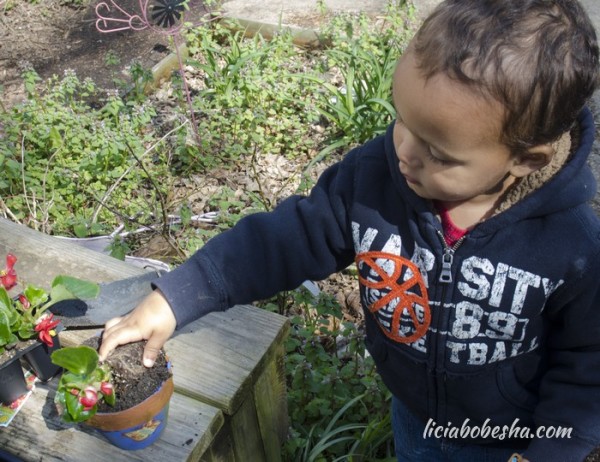Spring is finally here! To welcome the sun back, my two year old and I have been digging in the dirt. But this is more than just getting our hands dirty. We’re having fun science lessons outside.
If you haven’t gardened with your kids, you’re missing out. Gardening is a fabulous way to introduce science, nature, and healthy eating to children.
Here are some simple and fun ideas to get you started.
1. Plant beans in a cup.
Plant a couple of dried beans in dirt a plastic cup. Work on motor skills by allowing your child to scoop the dirt into the cup. Let him make a mess (that’s what the pros call a sensory experience).
Water the planted beans, stick in a sunny window, and watch them grow. Take photos every couple of days to mark the growth. Swipe through your slideshow as you spend time each day talking about the bean plants. Use words like seed, light, green, long, thin, leaves, grow, energy, and photosynthesis. Beans sprout really quickly that’s why this project has been a classroom favorite for decades.
2. Buy seedlings and plant in a pot.
Get a jumpstart on veggies or flowers by buying seedlings at your local garden center. Be sure to tour all the aisles, talking about all the plants and colors. Let your child have a say in the selection process. While you’re at the store, pick up a pot. Flowers don’t need a lot of space, but veggies like a few gallons of dirt. Large paint buckets are a good size to go tomatoes in. You can mix flowers and a veggies in large pots, so you have something pretty to look at while you wait on your vegetables to grow.
The changes from seedlings to mature plants is less dramatic than beans sprouting in a cup, but try weekly photos to document growth. Use words like bloom, pollinators, fruit, mature, ripen, and harvest! Don’t forget to talk about the five senses as you listen to birds sing, feel cool potting soil, smell blooming flowers, taste ripe vegetables, and of course see everything growing.
3. Dig a garden bed.
If you have the space and full sun, a garden bed in the ground is a great way to go. Let your little ones help you weed and stick their fingers in the soil to drop in the seeds. Just don’t be surprised if they try to add a handful of seeds at once. Use words like till, shovel, fertilize, pests, soil, clay, and worms!
The best thing about using the ground instead of a pot is you’ll see more roly-polies, beetles, and other creepy crawlies. This is a great opportunity to make a homemade book on “what we saw in the garden today.” Use your own photos and drawings after seeing new creatures. Use wikipedia to learn about the creatures you find to show how research works to teach us more about the world around us.
Regardless of whether you’re just sprouting beans in a cup, growing tomatoes in buckets, or planting a larger garden in the ground, gardening is a great jumping off point to teach your kids science. Children, and adults, benefit from learning that just like plants, people need water, sun, and a healthy environment to thrive. Turn your gardening project into an outdoor classroom. Compare and contrast the size and colors of the vegetables you harvest. Count the blooms on your flowers. Look for the ants and other insects that will visit your plants. These may seem like pretty minor things to do, but you can’t start too early teaching kids about nature and where our food comes from. It’s a science lesson they live every day.
How do you think you could use gardening to teach your kids about science and health?
***
Alicia lives and gardens in a small college town that often challenges her resolve to live as simply and as stress-free as possible. When she’s not working, rereading the same children’s books, cooking, or wondering how crunchy she’s become, she’s busy updating her site, liciabobesha.com. You can follow her on facebook.


